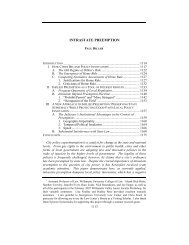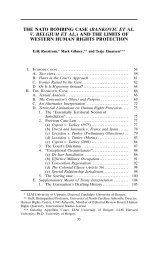the nature of representation: the cherokee right ... - Boston University
the nature of representation: the cherokee right ... - Boston University
the nature of representation: the cherokee right ... - Boston University
You also want an ePaper? Increase the reach of your titles
YUMPU automatically turns print PDFs into web optimized ePapers that Google loves.
2005] THE NATURE OF REPRESENTATION 99<br />
have said, ‘John Marshall has made his decision; now let him enforce it!’” 37<br />
1. Cherokees United Against Removal<br />
Initially, <strong>the</strong> Cherokee leadership was both publicly and privately united against<br />
<strong>the</strong> acceptance <strong>of</strong> land cessions and removal as <strong>the</strong> only option for <strong>the</strong> Cherokee. In<br />
1827, Major Ridge, who would later become an important member <strong>of</strong> <strong>the</strong> faction<br />
that signed <strong>the</strong> Treaty <strong>of</strong> New Echota, along with John Ross “reiterated <strong>the</strong> old<br />
stand <strong>of</strong> <strong>the</strong> Cherokees that not one single foot <strong>of</strong> soil would ever be sold.” 38 The<br />
Blood Law <strong>of</strong> 1829, which made unauthorized land concession a capital crime,<br />
reinforced <strong>the</strong> Cherokees’ position against ceding land. The law stated, “if any<br />
citizen or citizens <strong>of</strong> this nation should treat and dispose <strong>of</strong> any lands belonging to<br />
this nation without special permission from <strong>the</strong> national authorities, he or <strong>the</strong>y<br />
shall suffer death.” 39<br />
The Cherokee position found expression through <strong>the</strong> Cherokee national<br />
newspaper, <strong>the</strong> Cherokee Phoenix. The Phoenix had “a wide circulation in <strong>the</strong><br />
Cherokee Nation, <strong>the</strong> United States, and even parts <strong>of</strong> Europe.” 40 The paper<br />
conveyed <strong>the</strong> Cherokee perspective and <strong>the</strong>ir plight at <strong>the</strong> hands <strong>of</strong> <strong>the</strong> U.S., which<br />
was failing “to honor its treaty obligations.” 41 According to Helen Hunt Jackson’s<br />
influential writing on removal, it was precisely <strong>the</strong> “firm stand that <strong>the</strong>y would<br />
give up no more land” that inspired forced removal <strong>of</strong> Indians from Georgia. 42 The<br />
Cherokee Phoenix called attention to <strong>the</strong> Cherokee situation as <strong>the</strong> pressure for<br />
removal increased and, at least as was expressed to non-Cherokees, conveyed a<br />
united response not to engage in negotiations that would cede additional Cherokee<br />
land.<br />
37<br />
SCHLISINGER, supra note 3, at 26-27.<br />
38<br />
THURMAN WILKINS, CHEROKEE TRAGEDY: THE STORY OF THE RIDGE FAMILY AND THE<br />
DECIMATION OF A PEOPLE 196 (2nd ed., rev., 1986); see also, Letter from John Ross to<br />
John Lowrey (Oct. 22, 1830), in 1THE PAPERS OF CHIEF JOHN ROSS, supra note 14, at 204<br />
(“The Cherokees have long since come to <strong>the</strong> conclusion never again to cede ano<strong>the</strong>r<br />
foot <strong>of</strong> land.”); Letter fromJohn Ross, Major Ridge, George Lowrey, and Elijah Hicks to<br />
President James Monroe (Jan. 19, 1824), in 1THE PAPERS OF CHIEF JOHN ROSS, supra note<br />
14, at 59 (“The Cherokee Nation have now come to a decisive and unalterable<br />
conclusion not to cedeaway any morelands . . . .”).<br />
39<br />
WILKINS, supra note 38, at 201 (quoting <strong>the</strong> bill, passed on Oct. 24, 1829 in its<br />
entirety).<br />
40<br />
JILL NORGREN, THE CHEROKEE CASES: THE CONFRONTATION OF LAW AND POLITICS 45<br />
(1996).<br />
41<br />
Id.<br />
42<br />
Helen Hunt Jackson, Georgia’s Dishonor, in ACENTURY OF DISHONOR (1881)<br />
reprinted in THE REMOVAL OF THE CHEROKEE NATION: MANIFEST DESTINY OR NATIONAL<br />
DISHONOR? 99 (Louis Filler and Allen Guttmann eds., 1962).









